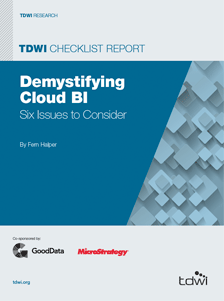
TDWI Checklist Report | Demystifying Cloud BI: Six Issues to Consider
August 14, 2014
Cloud BI has been positioned as the next evolution in business
intelligence because of the advantages the cloud provides in terms
of flexibility and elasticity. The cloud provides scalable storage,
computing power, and elastic resources. There is still confusion about
moving to a cloud model, and cloud BI adoption has been slow, relative
to some expectations. However, interest is definitely increasing. For
instance, in a recent 2014 TDWI survey, a majority of respondents
were either already using the cloud or were considering it for BI
and analytics. Companies that were using the cloud for analytics
were often using some combination of public, private, and hybrid
implementations.
Organizations still cite security and privacy as two major obstacles
to cloud adoption, although cloud vendors have worked hard to put
controls in place. Research by TDWI indicates that more organizations
are looking at matters such as extended governance when moving
to the cloud. Furthermore, TDWI research on big data suggests
organizations that incorporate the cloud as part of their analytics
ecosystem are more mature than those that do not. Clearly, cloud BI
and analytics are gaining steam as organizations work past some of
their concerns about the cloud and see its benefits.
This Checklist Report focuses on helping organizations demystify
several cloud BI issues. It examines the models emerging as
companies adopt the cloud. We also examine some of the real and
perceived issues regarding cloud adoption, including security,
governance, data management, and how the cloud impacts BI
deployments, in order to help readers better understand these
concerns.